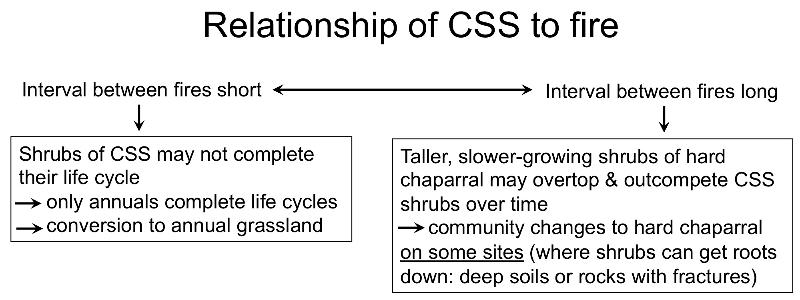Fire frequency and vegetation change
Read the last two pages of the excerpt from Halsey (2005).
From your previous lesson (Week 11):
Although chaparral vegetation is adapted to fire, fires that are too frequent can eliminate chaparral species. If a resprouting species is reburned 1-2 years after a fire, it may be unable to resprout again: it depletes its starch reserves in the root by producing new shoots after the first fire, then does not have time to build up enough starch reserves between fires to successfully resprout again. If an "obligate seeder" is burned, it will be eliminated from a site if a second fire occurs before the plants germinate, grow, mature and set seed. An obligate seeder is a species that dies in a fire and has seeds in a soil seed bank that are stimulated to germinate by smoke or heat. A fire will kill existing plants and stimulate germination. The germination will deplete the soil seed bank. No new seeds will be added to the soil seed bank until the seedlings grow into mature plants that flower and produce seeds. The species that are most vulnerable to a short fire-return interval (time between fires) are the obligate seeders that grow slowly and take many years to reach maturity and produce many seeds.
Most chaparral species can persist in areas where fire occurs once every 20-80 years. Some species can tolerate more frequent fires, but not all species.
Life history traits, together with fire adaptations, determine which plant species can persist on a site with a specific fire-free interval (years between fires).
Pertinent life history traits include:
- Longevity of the plant in a fire-free environment
- Longevity of the soil seed bank
- Age to reproduction
- Ability to resprout after shoot loss
Fire-responses that are not generally considered life-history traits, but are pertinent to population persistence under different fire regimes include:
- whether seed germination has a strict requirement for a fire cue or not
Coastal sage scrub dominants vs hard chaparral dominants
The dominant species of different vegetation types (e.g., chaparral, CSS, and annual grassland) differ dramatically in their life history traits. In some cases, this simply leads to successional changes after fire. Where species of both CSS and hard chaparral exist on a site, the CSS subshrubs may dominate the site for a few years, being outcompeted as time goes on by the slower-growing, but taller, hard chaparral dominants.
From your previous lesson (Week 11)
Dominant shrubs of coastal sage scrub include members of the mint family (black sage, white sage, purple sage, etc.) and California sagebrush. They tend to be shorter than shrubs of hard chaparral and mature more quickly, most maturing within four years. Therefore, although most of these shrubs are killed by fire, they can complete their life cycle in just a few years, and withstand more frequent fires than many species of hard chaparral. Fires that occur more frequently than once every four years, however, will tend to eliminate these shrubs, converting the site to an annual grassland.
These processes are summarized in the graphic below.

Once the vegetation on a site has been converted to annual grassland in Southern California, its return to other vegetation types is usually slow or non-existent. These sites have undergone "type conversion" to annual grassland.
Check your understanding: